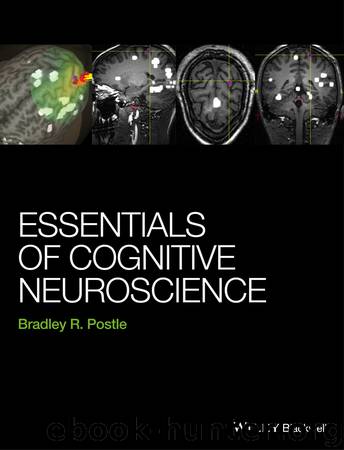Essentials of Cognitive Neuroscience by Postle Bradley R

Author:Postle, Bradley R.
Language: eng
Format: epub
ISBN: 9781118468272
Publisher: Wiley
Published: 2015-02-02T00:00:00+00:00
RESEARCH SPOTLIGHT
9.2 “The Fusiform Face Area: A Module in Human Extrastriate Cortex Specialized for Face Perception”
The proclamation of this title of the Kanwisher, McDermott, and Chun (1997) study remains provocative and controversial to this day. The study employed a block design, in which subjects viewed the serial presentation of unfamiliar faces (ID photos of Harvard undergraduates; Tip 9.8) alternating with serial presentation of control stimuli. Blocks were 30 seconds long; stimuli presented for 500 ms with an interstimulus interval of 150 ms. The experiment proceeded in three phases, the first an unapologetic “far and wide” search for regions that might respond with greater activity for faces vs. objects, the second and third more rigorous tests to replicate the phase 1 finding while ruling out potential confounds and further assessing the specificity of the regions identified in phase 1. The authors note that “Our technique of running multiple tests applied to the same region defined functionally within individual subjects provides a solution to two common problems in functional imaging: (1) the requirement to correct for multiple statistical comparisons and (2) the inevitable ambiguity in the interpretation of any study in which only two or three conditions are compared” (p. 4302). These statements are unpacked in Methodology Box 9.2.
In phase 1 of the study, 12 of 15 subjects showed significantly greater activity for faces than objects in the right fusiform gyrus, on the ventral surface of the temporal lobe, at the level of the occipitotemporal junction, and this region therefore became the focus of the subsequent scans. Phase 2, illustrated in Figure 9.3, panels 1B and 1C, was intended to rule out the potential confounds that the phase 1 results were due to (1) differences in luminance between face and object stimuli, or (2) the fact that the face, but not the object, stimuli were all exemplars drawn from the same category. Phase 3, illustrated in Figure 9.3, panels 2B and 2C, was intended to rule out the potential confound that the FFA was simply responding to any human body parts. Additionally, it established that FFA activity generalized to images of faces that were less easy to discriminate, and to a condition that imposed stronger attentional demands on the processing of stimuli, by requiring a decision of whether or not each stimulus matched the identity of the previous one.
Figure 9.3 Examples of stimuli, fMRI statistical maps, and time series, from several assays of response properties of the FFA. The contrast illustrated in panels 1A and 2A (faces > objects) was used to define the FFA ROI, outlined in green in the axial images, each for a different individual subject. Panels B and C illustrate the statistical map generated by each of the contrasts, each for the same subject, with the green-outlined ROI from panel A superimposed. This procedure was repeated on the individual-subject data of five subjects, and each time series is the average from the FFA ROI of each.
Source: Kanwisher, McDermott, and Chun, 1997. Reproduced with permission of the Society of Neuroscience.
Download
This site does not store any files on its server. We only index and link to content provided by other sites. Please contact the content providers to delete copyright contents if any and email us, we'll remove relevant links or contents immediately.
When Breath Becomes Air by Paul Kalanithi(7263)
Why We Sleep: Unlocking the Power of Sleep and Dreams by Matthew Walker(5641)
Paper Towns by Green John(4169)
The Immortal Life of Henrietta Lacks by Rebecca Skloot(3826)
The Sports Rules Book by Human Kinetics(3588)
Dynamic Alignment Through Imagery by Eric Franklin(3488)
ACSM's Complete Guide to Fitness & Health by ACSM(3467)
Kaplan MCAT Organic Chemistry Review: Created for MCAT 2015 (Kaplan Test Prep) by Kaplan(3422)
Introduction to Kinesiology by Shirl J. Hoffman(3299)
Livewired by David Eagleman(3121)
The River of Consciousness by Oliver Sacks(2992)
Alchemy and Alchemists by C. J. S. Thompson(2911)
The Death of the Heart by Elizabeth Bowen(2901)
Descartes' Error by Antonio Damasio(2731)
Bad Pharma by Ben Goldacre(2729)
Kaplan MCAT Behavioral Sciences Review: Created for MCAT 2015 (Kaplan Test Prep) by Kaplan(2491)
The Gene: An Intimate History by Siddhartha Mukherjee(2491)
The Fate of Rome: Climate, Disease, and the End of an Empire (The Princeton History of the Ancient World) by Kyle Harper(2436)
The Emperor of All Maladies: A Biography of Cancer by Siddhartha Mukherjee(2430)
